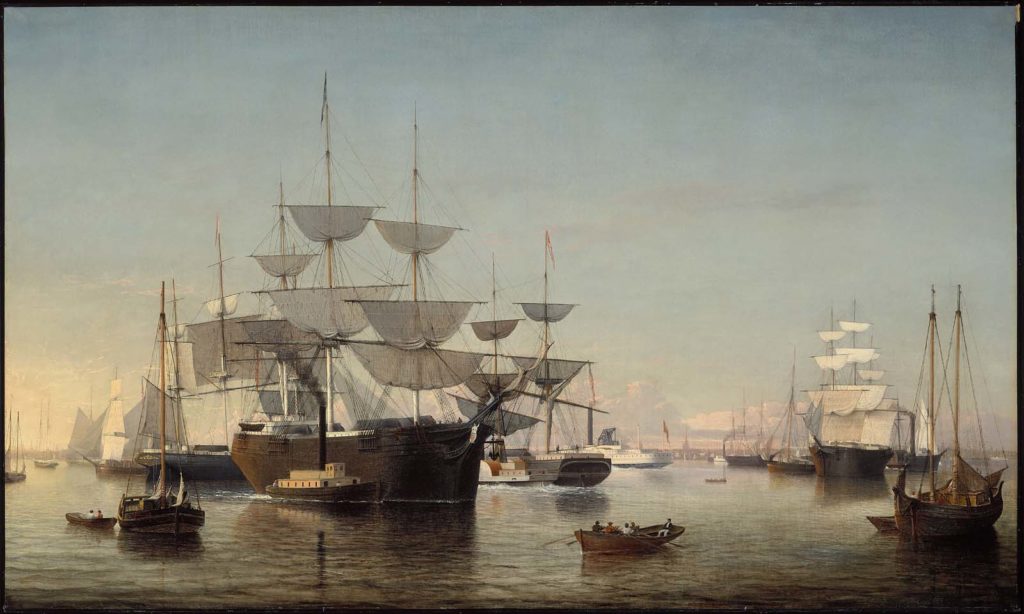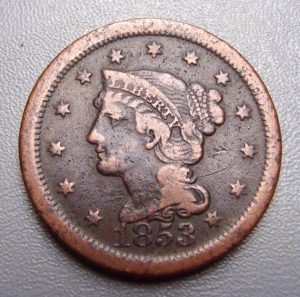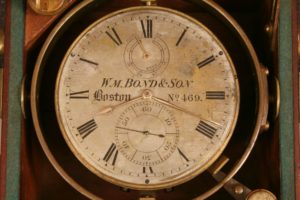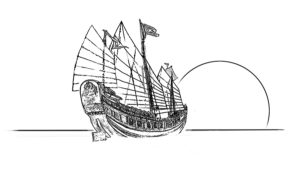Finding Finn
How research into the germ of an idea revealed my character and his story.
(I’ve developed a reading-plus-presentation on this topic and have been taking it to libraries and historical societies across Vermont and New Hampshire. Here are the basics.)
I spent more than two years researching and writing the first draft of Finn’s Clock, a fact that never fails to surprise the students I speak to as a guest author in their English classes. Now, every novel requires research, even if the story is a complete fantasy. My first novel, Sky Carver, is a good example. It’s not set in any country that I know of; it’s certainly not on the Earth we know. Instead, Carver’s World is an amalgam of river valleys I’ve visited or read about, with the additions of a city of canals and a wide bay marked with an archipelago of tall sea stacks.
My research included a couple of days in Venice when I was in high school, many trips to the coast of Maine, visits to the northeastern and northwestern islands of Scotland, and a three-week canoe trip down the Connecticut River, from the Canadian border to Long Island Sound.
I’ve done a bit of woodworking, and I already knew a great deal about canoes, wherries, and sailing craft, but I needed to learn about steamboats, particularly when it came time to write the third book in the Carver’s World series, Fireboy. And there was more research about ravens than you might have thought necessary.
The magic, on the other hand, is all made up. Of course, it’s based on the many other fantasies I’ve read throughout my life, but I added my own touches to create a “physics” of the system that made it more real to me. Magic in Carver’s World takes more than in-born talent, training, and practice; it also takes physical effort. Performing magic makes you tired, mentally and physically. Once I set that rule, I had to stick with it throughout the series.
Finn’s Clock was different
Finn’s Clock required a different type of research, or maybe I should say, a different depth of research. The story is set on this Earth, in a very real place and time. The place is the city of Boston, primarily on and around Boston Harbor. The time is 1853.

A view of Boston Harbor ca. 1854, by Fitz Henry Lane – a very busy place!
Once I set those rules, I had to learn everything I could about Boston in 1853: its geography, its architecture, its residents, and their lives. Culture, industry religion, politics – I had to know enough about all of it in order to make the story grounded, consistent, and believable.
And then I had to add the magic, not out of the blue, but out of the guts of the story, so that it too was consistent and believable.
The Germ of the Idea
I started the story with these thoughts: boats, a harbor, and marine chronometers. Why? I had read Dava Sobel’s Longitude, which describes the amazing story of a 14-year-long contest to discover a method sailors could use to calculate the longitude of their position at sea. (It’s far more exciting than it sounds; quite literally, thousands of lives were at stake.) The result was the invention, by one determined person, of an extremely reliable clock that could survive the conditions on board an 18th-century sailing ship.
I’ve been in love with sailing ships since reading C. S. Foresters’ Hornblower books in middle school. More recently, I had read an interesting history of the Whitehall boat (in the introduction to Building Catherine, by Richard Kolin), a type of working rowboat that originated in New York Harbor in the 1820s (or maybe in London’s Whitehall district at the same time). The boatmen who rowed out to meet incoming ships sounded like interesting characters working in a trade that was vital to the harbor economy but had been overlooked in the fictional world.
Why Boston, then, rather than New York? My wife and I had lived in Boston for the first two years of our marriage, and I had worked as carpenter’s apprentice and general gopher on the renovation of an old, ninety-five-foot-long fishing boat tied up at the end of Long Wharf. Just as important, Boston is only three hours away by car or bus, and it has a wonderful library.
That’s Where, but When?
So Boston it was, but when? The first marine chronometer was developed in the 1770’s but it took many years to perfect the design. The Whitehall type of boat was developed in the 1820s. A little research showed that Boston sea captains were slow to adopt the chronometer, trusting to their world-renowned skill at dead reckoning, but the city did boast one well-known maker of marine chronometers in the early 19th century: William Bond & Sons. (The company survived from 1793 until the 1970s!)
That gave me a pretty wide window of opportunity, but I wanted it to be during the great Age of Sail, while not too close to the Civil War. Boston was a hotbed of abolitionism, which would provide lots of tension and plot opportunities, but for me to write a book about slavery or the life of a freed or runaway slave seemed presumptuous at the time. It still does; I simply don’t feel qualified to tell an Afro-American story.
On the other hand, my research quickly reminded me about the Irish Potato Famine of the late 1840s and the intense prejudice against Irish immigrants that developed after millions of them poured into Boston (and every other North American coastal city) during the famine and for many years thereafter. That set a starting point sometime after 1846.

My grandmother’s 1853 penny.
In the end, the choice of 1853 was not driven by any one historical event. It just so happens that I possess an 1853 U.S. penny, which had been my father’s, and his mother’s, and very possibly her father’s or mother’s. It’s the size of a quarter, has a nice heft to it, and bears the marks of use, but it’s in pretty darn good shape. I thought, why not? At the time, it didn’t seem like a year or two to either side would matter.
Big Things did Happen in 1853
As it turned out, it did matter, because 1853 saw the launching of the Great Republic, the largest wooden clipper ship ever built, and it happened in Boston Harbor. That was something I couldn’t leave out.
It turns out that 1853 also saw what was probably the very first bungee jump in the world – a man dressed like Mercury who jumped from the basket of a hot air balloon with a 300-foot-long India rubber rope looped through a harness on his back. The event took place in Paris, however, so I couldn’t include it, but it was reported in The Boston Herald, which I read in detail from June through November of 1853. Luckily, the Boston Public Library has every issue on microfilm.
I made two trips down to Boston to pore over the microfilms and take notes. I discovered that there were indeed help-wanted ads that specified no Irish need apply, that there were music halls showing Irish-themed plays (including a parody of Uncle Tom’s Cabin), and that women’s suffrage was as big a theme as abolition, at least in the mind of the editor of The Boston Herald, who seemed a bit conservative on the issue.
Librarians are my Heroes!
I also spent a lot of time in the map room there and at the Baker Library of Dartmouth College, which is just a half-hour’s drive from my home. I found wonderful three-dimensional maps of Boston from 1850 through 1853, along with an 1857 chart of Boston Harbor and the surrounding bay. My wife and I prowled the waterfront of Boston, looking for (and finding) buildings that had been built before 1853. I learned that Boston is the most land-filled city in the world. One weekend, we stayed in a hotel just half a block seaward from the Boston Customs House. The hotel would have been underwater in 1853.
I read Boston’s Immigrants, 1790-1880: a study in acculturation, by Oscar Handlin. With its maps, tables, period lithographs, and clear descriptions of the immigrant experience, it proved invaluable, the source of so much background for the Irish immigrant family who became the focus of Finn’s Clock. If it hadn’t been for this book, I might never have found my hero, Finn O’Neill.
I also read books about Boston’s China trade and learned that a Chinese Junk named Keying had sailed from China to New York, Boston, and London in 1847. I learned that the Chinese Mandarins were fascinated by clocks and clockwork devices but, prior to the 20th Century, the Chinese had never developed clock making as an industry. Instead, they bought their clocks and gadgets from Europeans based in Macao and other trade ports.

A chronometer made by Wm. Bond & Son in the 1850s.
While the Irish migration gave me Finn and his family, the Keying gave me An-Ming and her father, Matthew Lawson; and the combination of Bond & Son and the Chinese fascination with clocks was the genesis of Peter Jenkins, the chronometer man. My characters and the plot around them grew from these seeds of truth.
Back to the Magic
If you’ve read this far, you realize that I enjoy doing all the research that a good story requires. The facts are fodder for my imagination. But what about the magic?
Finn’s Clock is different from Sky Carver in another important aspect: the point of view. Finn tells his own story, in the first person. He has no knowledge of magic, Chinese or otherwise. He can’t do it and he can’t explain it. All he can do is experience the results. The same is true for the reader, and I think that strengthens the bond between them.
It’s also an important part of the plot, and it doesn’t make the magic any less real in the historic context of the story, which is as accurate as I could make it. Everything around the magic could have happened just as I’ve described it. A couple of scenes really did happen, and you can read about them in The Boston Herald. Just add Finn and his friends . . .
It’s Boston, 1853, and into the harbor sails a Chinese Junk bearing mysteries and magic.
